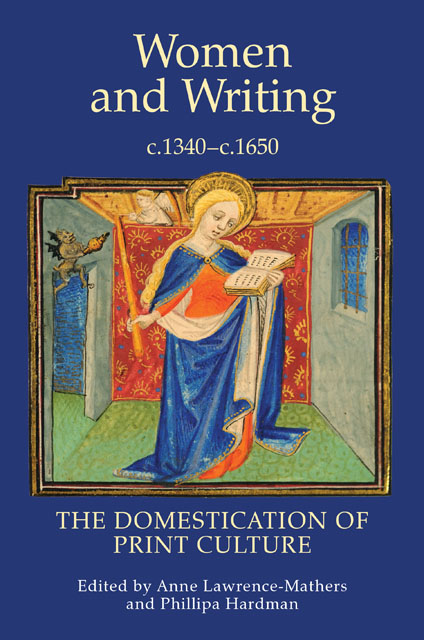Book contents
- Frontmatter
- Contents
- List of Plates
- List of Contributors
- Abbreviations
- Introduction
- Domestic Learning and Teaching: Investigating Evidence for the Role of ‘Household Miscellanies’ in Late-Medieval England
- Domesticating the Calendar: The Hours and the Almanac in Tudor England
- ‘a briefe and plaine declaration’: Lady Anne Bacon’s 1564 Translation of the Apologia Ecclesiae Anglicanae
- Frances Wolfreston’s Chaucer
- Commonplace Book Culture: A List of Sixteen Traits
- Women, Politics and Domesticity: The Scribal Publication of Lady Rich’s Letter to Elizabeth I
- ‘yr scribe can proove no nessecarye consiquence for you’?: The Social and Linguistic Implications of Joan Thynne’s using a Scribe in Letters to her Son, 1607–11
- Fathers and Daughters: Four Women and Their Family Albums of Verse
- The Book as Domestic Gift: Bodleian MS Don. C. 24
- ‘like hewen stone’: Augustine, Audience and Revision in Elizabeth Isham’s ‘Booke of Rememberance’ (c. 1639)
- Female Voices in Early Seventeenth Century Pamphlet Literature
- Select bibliography
- Index
- Misscellanious Endmatter
Domestic Learning and Teaching: Investigating Evidence for the Role of ‘Household Miscellanies’ in Late-Medieval England
Published online by Cambridge University Press: 01 March 2023
- Frontmatter
- Contents
- List of Plates
- List of Contributors
- Abbreviations
- Introduction
- Domestic Learning and Teaching: Investigating Evidence for the Role of ‘Household Miscellanies’ in Late-Medieval England
- Domesticating the Calendar: The Hours and the Almanac in Tudor England
- ‘a briefe and plaine declaration’: Lady Anne Bacon’s 1564 Translation of the Apologia Ecclesiae Anglicanae
- Frances Wolfreston’s Chaucer
- Commonplace Book Culture: A List of Sixteen Traits
- Women, Politics and Domesticity: The Scribal Publication of Lady Rich’s Letter to Elizabeth I
- ‘yr scribe can proove no nessecarye consiquence for you’?: The Social and Linguistic Implications of Joan Thynne’s using a Scribe in Letters to her Son, 1607–11
- Fathers and Daughters: Four Women and Their Family Albums of Verse
- The Book as Domestic Gift: Bodleian MS Don. C. 24
- ‘like hewen stone’: Augustine, Audience and Revision in Elizabeth Isham’s ‘Booke of Rememberance’ (c. 1639)
- Female Voices in Early Seventeenth Century Pamphlet Literature
- Select bibliography
- Index
- Misscellanious Endmatter
Summary
‘Thus taughte me my dame’ – so characters in Chaucer’s Canterbury Tales refer to things they have known from their earliest youth. These words are used by both the narrator of the ‘Manciple’s Tale’ and the tavern boy in the ‘Pardoner’s Tale’, to authorize their quotation of a piece of traditional wisdom.1 The tavern boy refers to his mother’s teaching him always to be prepared to face death (683), an example of the sombre but salutary dicta prominent in the formation of Christian children from medieval to Victorian times. The Manciple recalls his mother’s repeatedly instructing him to be sparing of speech (318–62), in terms that echo Cato’s Distichs, that most celebrated of medieval educational texts. The elementary status of the teaching is made explicit:
The firste vertu, sone, if thou wolt leere,
Is to restreyne and kepe wel thy tonge;
Thus lerne children whan that they been yonge. (332–4)
As this easy, almost casual reference to maternal instruction implies, the role of mothers as the first teacher of their children and the domestic environment as the place of early learning could be taken for granted among Chaucer’s fourteenth- century readers and audience. Similarly, Nicholas Orme draws attention to a ‘telling phrase in the late-medieval educational treatise Femina (“Woman”) that “woman teacheth child on book”’.
The books most likely to be used by mothers teaching their children to read and to know the essential prayers for their practice of religion were books of hours or primers which, as Patricia Cullum and Jeremy Goldberg point out, ‘regularly contained the Paternoster, the Ave, and the Creed, which all youngsters were supposed to learn by rote. Some even contain an alphabet.’ As Orme explains, reciting the alphabet was itself ‘a Christian task … pronounced like a prayer’.
- Type
- Chapter
- Information
- Women and Writing, c. 1340-c. 1650The Domestication of Print Culture, pp. 15 - 33Publisher: Boydell & BrewerPrint publication year: 2010

